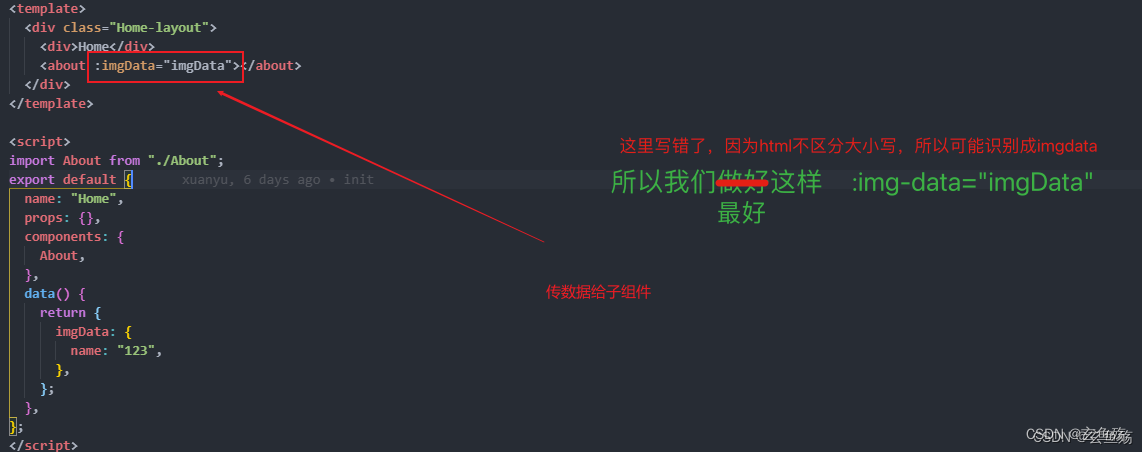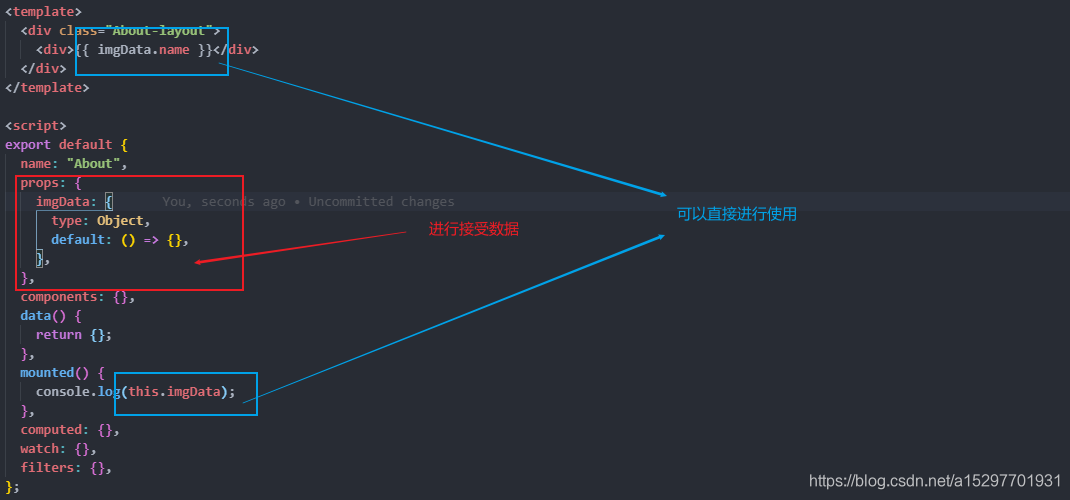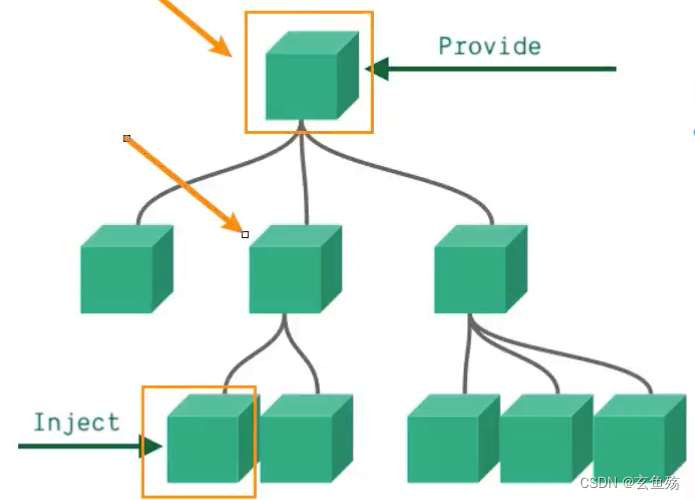一、父子组件传值
1.最常用的
01-父组件传递数据

02-子组件接受数据

**03-子组件发射事件 **

04-父组件中感知

2.使用Ref
子组件
<template>
<div class="son-layout">
<h3>{{ name }}</h3>
</div>
</template>
<script>
export default {
name: 'son',
data() {
return {
name: 'son'
};
},
methods: {
getName() {
console.log('son :>> ', this.name);
}
}
};
</script>
<style></style>
父组件
<template>
<!-- 设定ref -->
<son ref="sonRef" />
<button @click="getSonInfo">getSonInfo</button>
</template>
<script>
import Son from './son.vue';
export default {
components: { Son },
data() {
return {};
},
methods: {
getSonInfo() {
// this.$refs.sonRef 获取到子组件
// 获取子组件中数据
console.log(this.$refs.sonRef.name);
// 更改子组件中数据 tip : 强烈不建议更改,不易于维护
this.$refs.sonRef.name = '我更改了'
// 使用子组件中方法
this.$refs.sonRef.getName();
}
}
};
</script>
<style scoped></style>
二、非直接父子传值 ( 有嵌套关系 )
**使用provide 与 inject **
比如一些深度嵌套的子组件,想要获取父组件的部分内容
父组件 ( 祖先组件 ) :provide 提供数据
子组件 :inject 使用这个数据

**父组件 ( 祖先组件 ) **
- 静态数据
export default {
name: 'ancestor',
// 提供数据
provide:{
name:'我是祖先',
age:345
}
};
- ** 使用data中的数据 **
export default {
name: 'ancestor',
// 注意,如果需要拿data中的数据,需要这么来写,provide写成一个方法
provide() {
return {
name: '我是祖先',
// 这样才能拿到数据,vue内部做了个绑定
age: this.ageArr
};
},
data() {
return {
ageArr: [18, 19, 20, 21]
};
}
}
- 使用data中的数据
tip : 在vue3中,如果没有响应式,可以这样写 , 现在不使用应该也是响应式的
// 从vue中导入computed函数
import { computed } from 'vue'
export default {
name: 'ancestor',
provide() {
return {
name: '我是祖先',
// 使用computed包裹一下
age: computed(() => this.ageArr)
};
},
data() {
return {
ageArr: [18, 19, 20, 21]
};
}
}
子组件
<template>
<div class="Home-layout">
<!-- 使用数据 -->
{{name}} - {{age}}
</div>
</template>
<script>
export default {
name: 'son',
// 拿到需要的祖先数据
inject: ['name', 'age']
};
</script>
三、非父子传值 ( 无嵌套关系 )
**1.vuex的存取值 **
可以看我之前写的vuex的文章哦~
Vue 之 封装Vuex
2.全局事件总线 (vue2)
// 在入口 main.js 中,创建一个 bus 总线,这样全局都可以使用
Vue.prototype.$bus = new Vue()
// 在组件中使用
发射事件 this.$bus.$emit('change')
接受事件 this.$bus.$on('change', ()=>{} )
// 记得注销
//通常绑定在钩子函数beforeDestroy()或者destroyed()中
//如果使用了keep-alive包裹,可以写在deactivated钩子函数中
注销事件 this.$bus.$off('change')
3. 全局事件总线Mitt(vue3)
vue3中移除了$on、$off、$once方法,所以想要继续使用,要通过第三方库,使用mitt
01-安装
npm install mitt
02-封装一下
新建eventbus.js
// 导入
import mitt from 'mitt';
// 创建
const emitter = mitt();
// 导出
export default emitter;
03-发射事件
<template>
<div class="son-layout">
<button @click="emitSon">son</button>
</div>
</template>
<script>
// 导入封装的
import emitter from '../assets/eventBus';
export default {
name: 'son',
methods: {
emitSon() {
console.log('我发射啦');
// 使用
emitter.emit('sonEmit', { name: '我是son' });
}
}
};
</script>
<style></style>
04-监听事件
<template>
<div class="zhong-layout">zhong</div>
</template>
<script>
// 导入
import emitter from '../assets/eventBus';
export default {
name: 'zhong',
mounted() {
// 监听sonEmit事件
emitter.on('sonEmit', (value) => {
console.log(value.name, '收到啦');
});
// 监听所有事件 type : 事件的名字 info:对应的数据
// 如果有两个事件,会执行两次,不会有冲突哒~
emitter.on('*', (type, info) => {
console.log(info);
console.log('* listener', type, info);
});
},
};
</script>
<style>
</style>
05-取消事件
// 取消所有的事件监听
emitter.all.clear()
// 取消指定事件监听,方法要使用同一个 如 : sonEmit.
function onFoo(){}
emitter.on('sonEmit', onFoo)
emitter.off('sonEmit', onFoo)
版权归原作者 玄鱼殇 所有, 如有侵权,请联系我们删除。